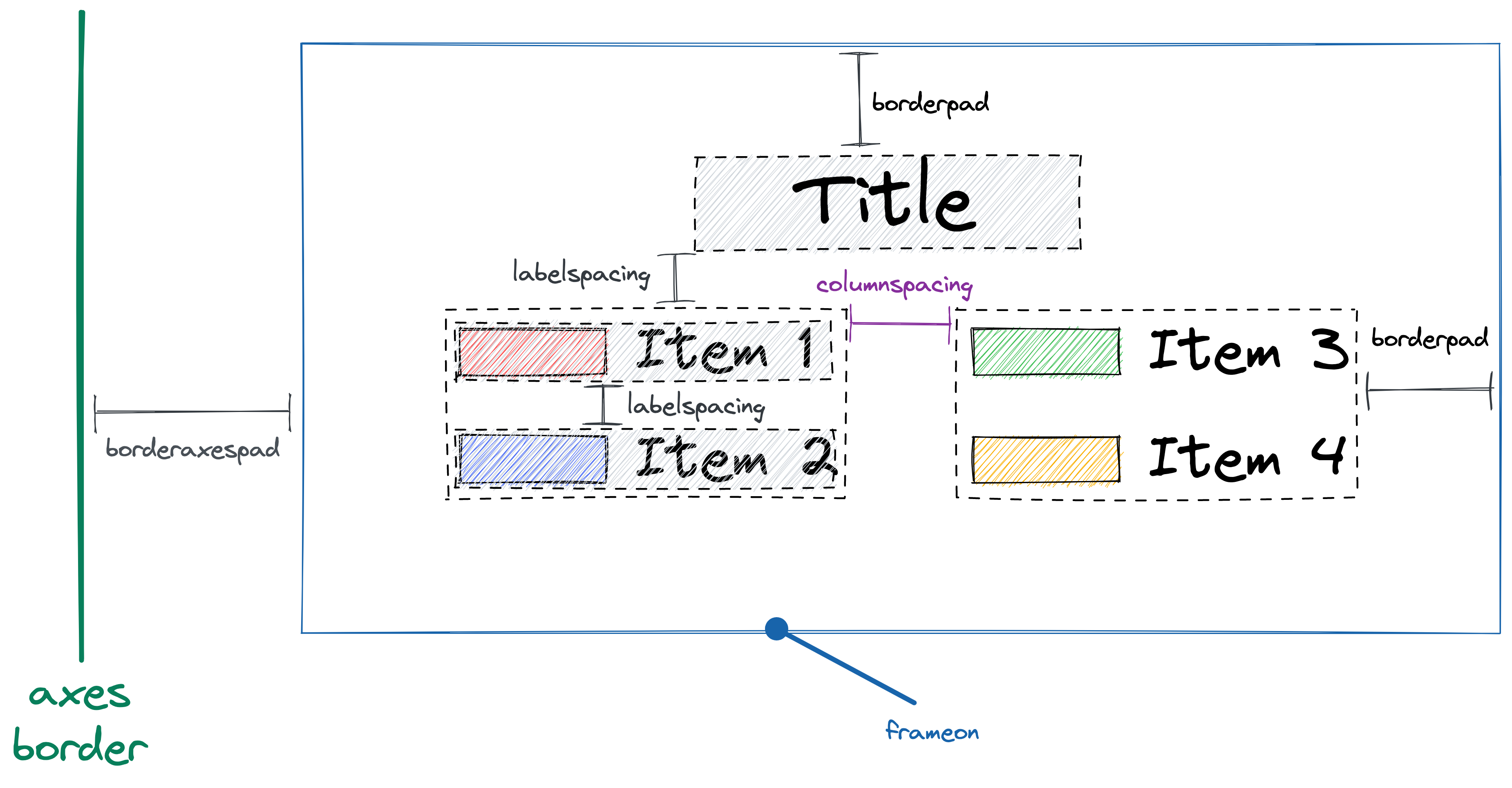Legend creating and manipulation with ease for matplotlib
Project description

When you want to create or adjust the legend in matplotlib, things can get dirty. LegendKit may solve your headache.

Features
- Easy title placement and alignment
- Layout for multiple legends
- Easy colorbar
Installation
pip install legendkit
Usage
Any parameters you can use in legend or colorbar in matplotlib can also be used here.
Use it as the same old day
First create a plot
Usually, this is how you create the legend, the long title looks bad when it place at the center. But you can do nothing about it.
import numpy as np
import matplotlib.pyplot as plt
x = np.arange(0, 10, 0.1)
plt.plot(x, np.sin(x), color="r", label="sin")
plt.plot(x, np.sin(x), color="r", label="cos")
plt.legend(title="Trigonometry Functions")
With legendkit, things are easy, replace the default legend creation
from legendkit import legend
# plt.legend(title="Trigonometry Functions")
legend(title="Trigonometry Functions", title_align="left")

You can even create legend like this
legend(title="Trigonometry Functions", title_pos="left", ncol=2)

Create Colorbar
from legendkit import Colorbar, EllipseColorbar
Colorbar(vmin=0, vmax=10, title="Colorbar", title_align="left")
EllipseColorbar(vmin=0, vmax=10, title="Ellipse Colorbar", title_align="left")
Using preset legend
import matplotlib.pyplot as plt
from legendkit import CatLegend, SizeLegend
_, ax = plt.subplots()
CatLegend(["r", "g", "b"], ["Item 1", "Item 2", "Item 3"])
SizeLegend([i for i in range(101)])
Create a custom legend
If you want to create a custom legend, it's pretty easy to do it. Simple use an array to define it.
from legendkit import legend
legend(legend_items=[
# (handle, label, config)
('square', 'Item 1', {'color': '#01949A'}),
('circle', 'Item 2', {'facecolor': '#004369',
'edgecolor': '#DB1F48',
'linewidth': 0.5}),
('rect', 'Item 3', {'color': '#E5DDC8'}),
# Or you can have no config at all
('line', 'Item 4'),
])

Or you can use matplotlib legend handlers for richer definition.
LegendKit provides you with some predefined handlers to use out of the box.
from legendkit import legend
from legendkit.handles import SquareItem, CircleItem, RectItem, LineItem
from matplotlib.lines import Line2D
legend(
handles=[SquareItem(), CircleItem(), RectItem(), LineItem(), Line2D([], [])],
labels=['Square', 'Circle', 'Rect', 'Line', 'Matplotlib Line'
])

If you want to use highly customized element as entry, please refer to here
Composing multiple legends
Sometimes you may want to group few legends together
vstackis used to stack legends verticallyhstackis used to stack legends horizontally
import matplotlib.pyplot as plt
from legendkit import legend
from legendkit.layout import vstack, hstack
_, ax = plt.subplots()
legend1 = legend(legend_items=[
('circle', 'The Moon', {'color': '#41729F'}),
], title="Earth's Moon")
legend2 = legend(legend_items=[
('circle', 'Deimos', {'color': '#3D550C'}),
('circle', 'Phobos', {'color': '#81B622'}),
], title="Mars' Moons")
legend3 = legend(legend_items=[
('circle', 'Io', {'color': '#FB4570'}),
('circle', 'Europa', {'color': '#FB6B90'}),
('circle', 'Ganymede', {'color': '#FB8DA0'}),
('circle', 'Callisto', {'color': '#EFEBE0'}),
], title="Moons of Jupyter")
legends = hstack([legend1, legend2, legend3], title="Moons in solar systems", spacing=10, frameon=True)
ax.add_artist(legends) # Make sure you add it to the axes, or it won't be rendered

Understand layout in matplotlib legend
If you are familiar with css flexbox model, this is similar to how legend is layout internally in matplotlib.
A matplotlib legend have at least two parts, the handle and the label.
- handle: The graphic to represent the item in the plot.
- label: The text for the item.
Parameters to control the layout
The units used in the layout system is the same as font size.

Control the handle
- handleheight: The height of the handle.
- handlelength: The length of the handle.
Control the handle and the label:
- handletextpad: the distance between the handle and the label.

Control between different items:
- labelspacing: This control the distance between different legend items, it also controls the distance between title and items.
- columnspacing: The distance between multiple columns of items.
Control the legend outer frame:
- frameon: Toggle the on/off of the outer frame.
- borderpad: The distance between the actual legend and the outer frame, apply for both x and y direction.
- borderaxespad: The distance between the axes and the legend.
Project details
Release history Release notifications | RSS feed
Download files
Download the file for your platform. If you're not sure which to choose, learn more about installing packages.
Source Distribution
Built Distribution
Hashes for legendkit-0.1.2-py3-none-any.whl
| Algorithm | Hash digest | |
|---|---|---|
| SHA256 | 6234c5e1808037f61d77722097359e07c171f5c2ea40dc4439e6b9bb8aeb7804 |
|
| MD5 | 827496cf17985ef5077d195ffe46d421 |
|
| BLAKE2b-256 | 33bff385d6833dd46f84fc5399e572159caa49e5f65475f421ac55691bbee4b3 |












